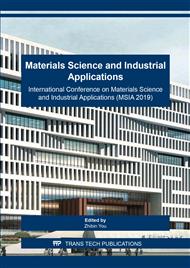[1]
Maeda, K., et al., Chemical compass model of avian magnetoreception. Nature, 2008. 453(7193): pp.387-90.
Google Scholar
[2]
Henbest, K.B., et al., Radio frequency magnetic field effects on a radical recombination reaction: a diagnostic test for the radical pair mechanism. Journal of the American Chemical Society, 2004. 126(26): pp.8102-3.
DOI: 10.1021/ja048220q
Google Scholar
[3]
Ritz, T., et al., Resonance effects indicate radical pair mechanism for avian magnetic compass. Nature, 2004. 429(6988): pp.177-80.
DOI: 10.1038/nature02534
Google Scholar
[4]
Mouritsen, H., et al., Magnetoreception and its use in bird navigation. Current Opinion in Neurobiology, 2005. 15(4): pp.406-414.
DOI: 10.1016/j.conb.2005.06.003
Google Scholar
[5]
Wiltschko, R., et al., Magnetoreception. Bioessays, 2006. 28(2): p.157–168.
Google Scholar
[6]
Schulten, K., Magnetic field effects in chemistry and biology. 1982. 61-83.
Google Scholar
[7]
Schulten, K., et al., A Biomagnetic Sensory Mechanism Based on Magnetic Field Modulated Coherent Electron Spin Motion. Zeitschrift Für Physikalische Chemie, 1978. 111(1): pp.1-5.
DOI: 10.1524/zpch.1978.111.1.001
Google Scholar
[8]
Hore, P.J., et al., The Radical-Pair Mechanism of Magnetoreception. Annual Review of Biophysics, 2016. 45(1): pp.299-344.
DOI: 10.1146/annurev-biophys-032116-094545
Google Scholar
[9]
Worster, S., et al., Spin relaxation of radicals in cryptochrome and its role in avian magnetoreception. Journal of Chemical Physics, 2016. 145(3): p.133.
DOI: 10.1063/1.4958624
Google Scholar
[10]
Hiscock, H.G., et al., The quantum needle of the avian magnetic compass. Proc Natl Acad Sci U S A, 2016. 113(17): p.201600341.
Google Scholar
[11]
Jogler, C., et al., Genomics, Genetics, and Cell Biology of Magnetosome Formation - Annual Review of Microbiology, 63(1):501.
DOI: 10.1146/annurev.micro.62.081307.162908
Google Scholar
[12]
Gauger, E.M., et al., Comment on Quantum coherence and sensitivity of avian magnetoreception,. Physical Review Letters, 2013. 110(17): p.178901.
DOI: 10.1103/physrevlett.110.178901
Google Scholar
[13]
Bandyopadhyay, et al., Bandyopadhyay, Paterek, and Kaszlikowski reply. Physical Review Letters, 2013. 110(17): p.178902.
DOI: 10.1103/physrevlett.110.178902
Google Scholar
[14]
Cai, J., et al., Chemical compass model for avian magnetoreception as a quantum coherent device. Physical Review Letters, 2013. 111(23): p.230503.
DOI: 10.1103/physrevlett.111.230503
Google Scholar
[15]
C.R. Timmel, et al., Effects of weak magnetic fields on free radical recombination reactions. Molecular Physics, 1998. 95(1): pp.71-89.
DOI: 10.1080/002689798167395
Google Scholar
[16]
Chunlei Shao, Quantum Control Direction in the Migration Birds. 2016, Dalian University of Technology.
Google Scholar
[17]
R.C, Electron spin resonance. Theory and applications : N.M. Atherton, Ellis Horwood Ltd., Chichester, distributed by John Wiley and Sons Inc. Journal of Molecular Structure, 1975. 28(2): pp.447-448.
Google Scholar


